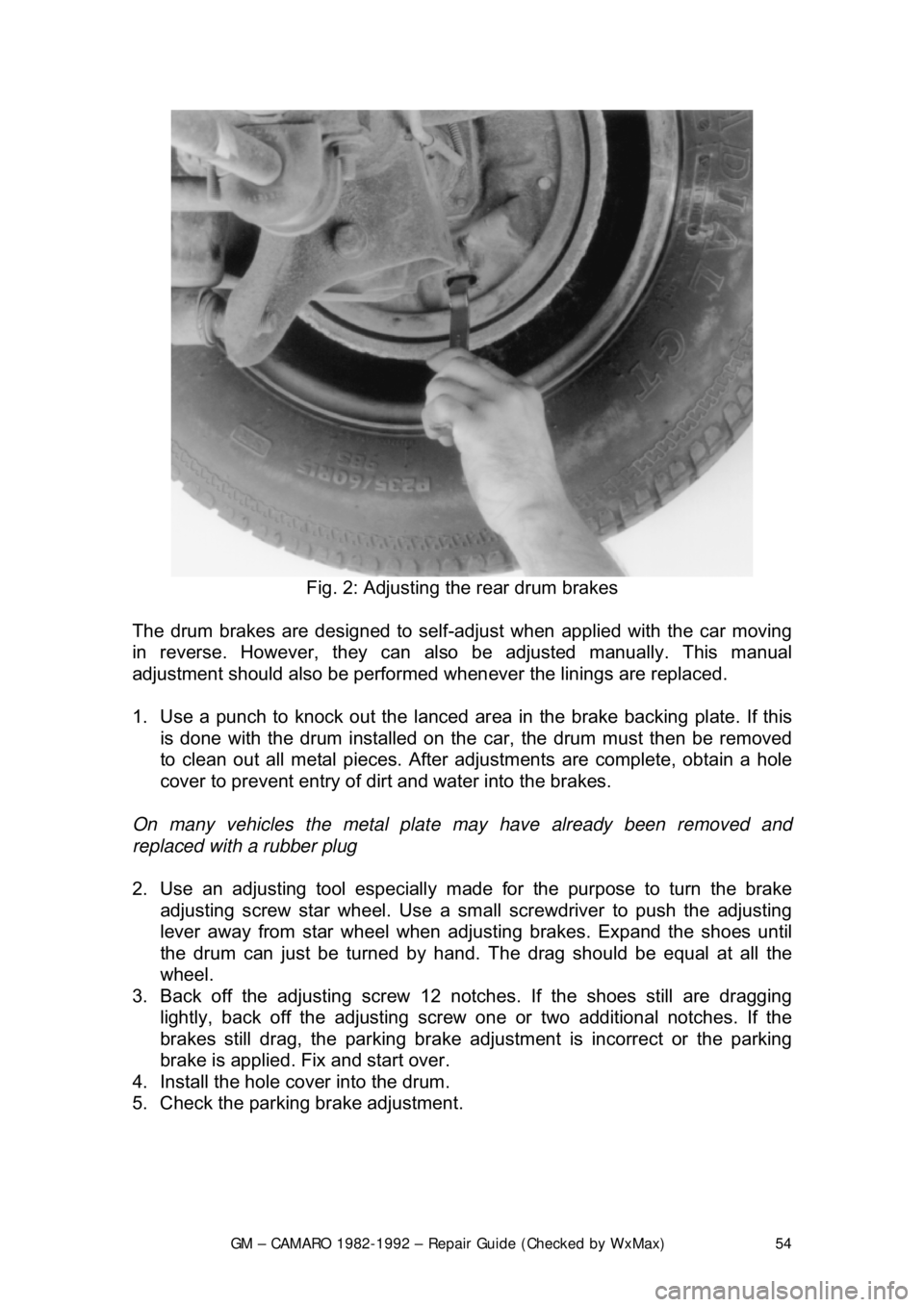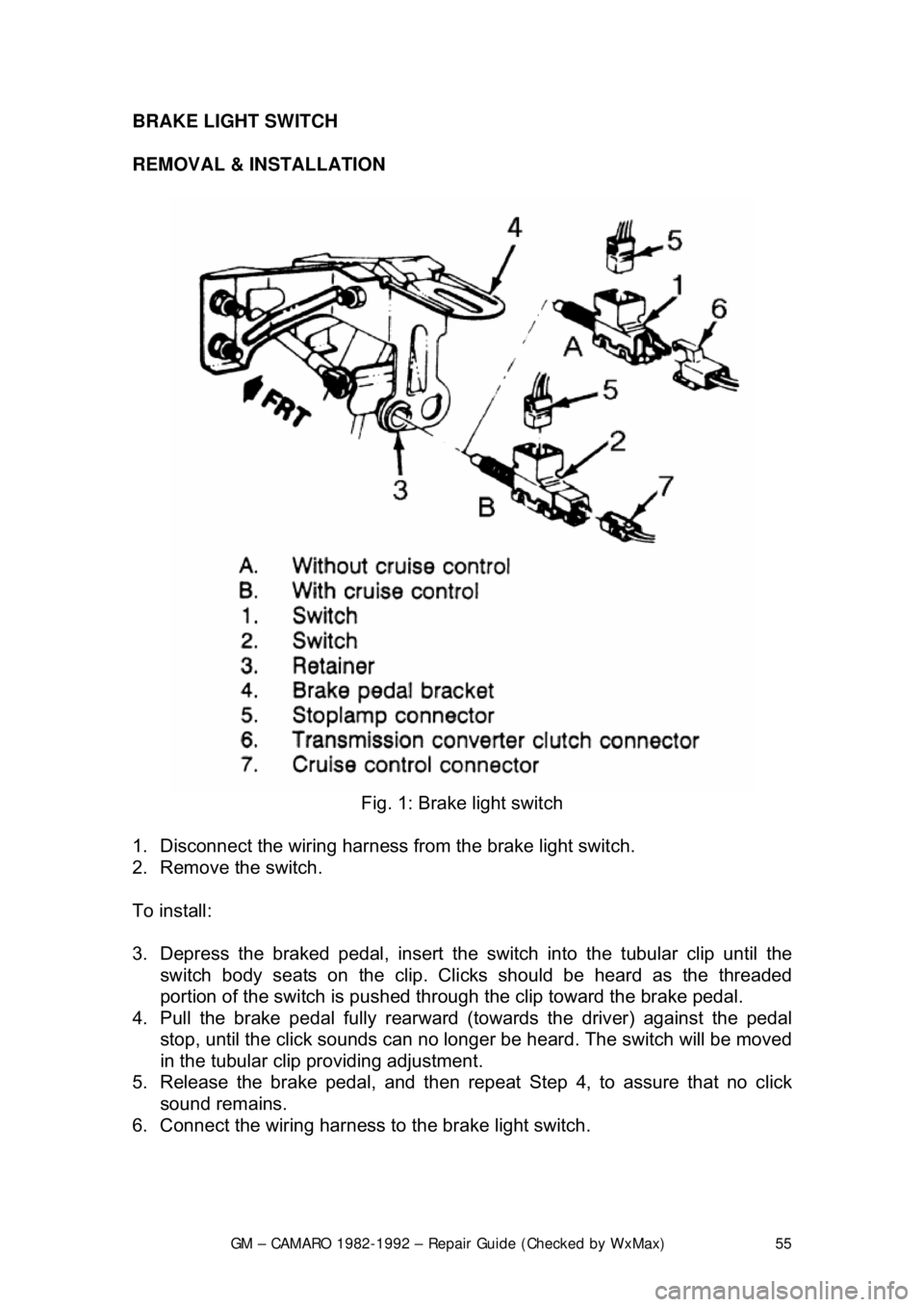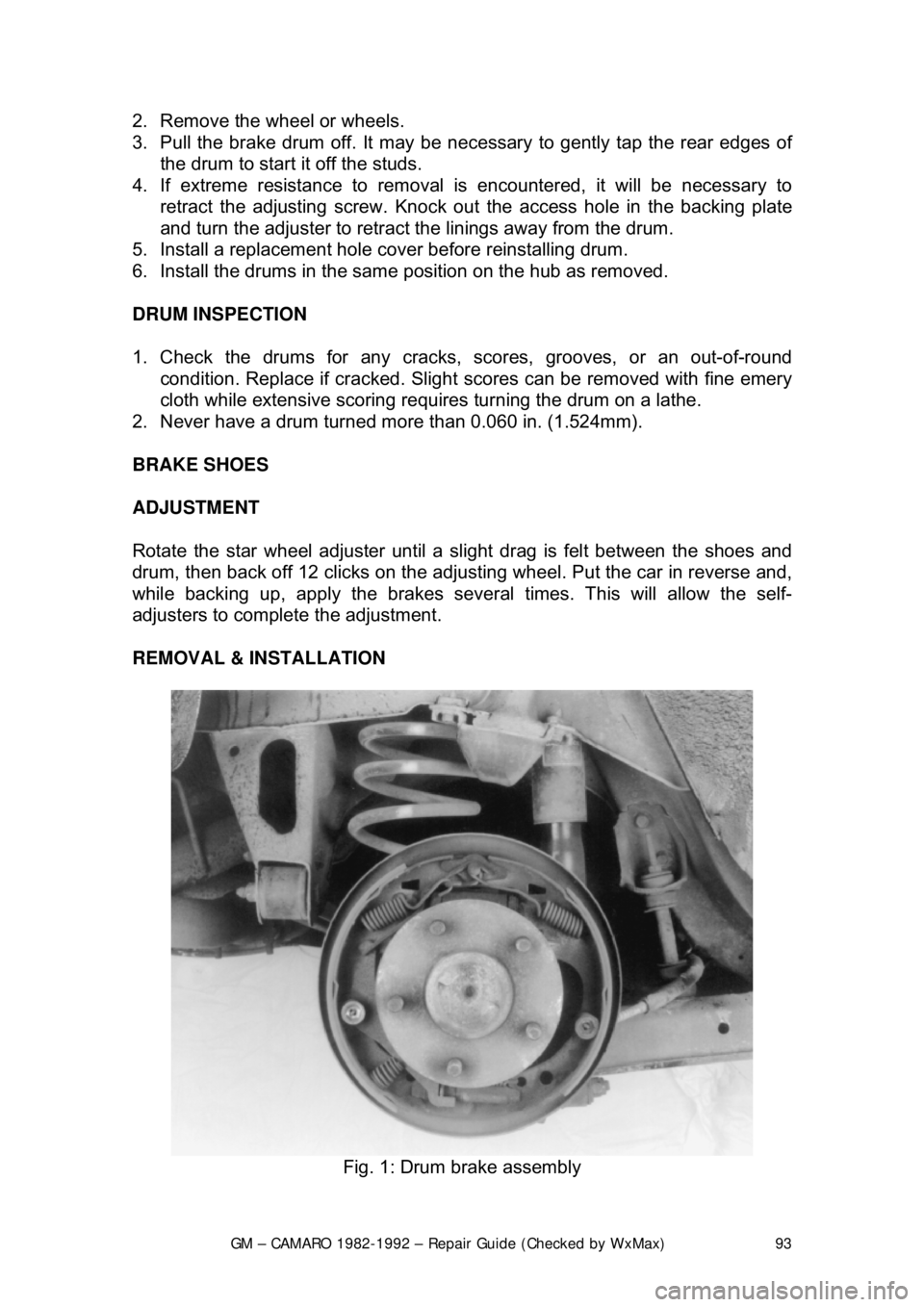brake light CHEVROLET CAMARO 1982 Repair Guide
[x] Cancel search | Manufacturer: CHEVROLET, Model Year: 1982, Model line: CAMARO, Model: CHEVROLET CAMARO 1982Pages: 875, PDF Size: 88.64 MB
Page 49 of 875

GM – CAMARO 1982-1992 – Repair Guide (Checked by WxMax) 49
Upon release of the brake pedal, a spri
ng located inside the master cylinder
immediately returns the master cylinder pistons to the normal position. The
pistons contain check valv es and the master cylinder has compensating ports
drilled in it. These are uncovered as the pistons reach their normal position. The
piston check valves allow fluid to flow to ward the wheel cylinders or calipers as
the pistons withdraw. Then, as the return springs force the brake pads or shoes
into the released position, the excess fluid reservoir through the compensating
ports. It is during the time the pedal is in the released position that any fluid that
has leaked out of the syst em will be replaced through the compensating ports.
Dual circuit master cylinders employ tw o pistons, located one behind the other,
in the same cylinder. The primary pist on is actuated directly by mechanical
linkage from the brake peda l through the power booster. The secondary piston
is actuated by fluid tra pped between the two pistons. If a leak develops in front
of the secondary piston, it moves forward until it bottoms against the front of the
master cylinder, and the fluid trapped betw een the pistons will operate the rear
brakes. If the rear brakes develop a l eak, the primary piston will move forward
until direct contact with the secondary pi ston takes place, and it will force the
secondary piston to actuate the front brakes. In either case, the brake pedal
moves farther when the brakes are applied, and less braking power is available.
All dual circuit systems use a switch to wa rn the driver when only half of the
brake system is operational. This switch is usually located in a valve body which
is mounted on the firewall or the frame below the master cylinder. A hydraulic
piston receives pressure from both circui ts, each circuit's pressure being applied
to one end of the piston. When the pressures are in balance, the piston remains
stationary. When one circuit has a leak, however, the greater pressure in that
circuit during application of the brakes will push the piston to one side, closing
the switch and activating the brake warning light.
In disc brake systems, this valve body also contains a metering valve and, in
some cases, a proportioning valve. The metering valve keeps pressure fro\
m
traveling to the disc brakes on the front wheels until the brake shoes on the rear
wheels have contacted the drums, ensuri ng that the front brakes will never be
used alone. The proportioning va lve controls the pressure to the rear brakes to
lessen the chance of rear wheel lo ck-up during very hard braking.
Warning lights may be tested by depressi ng the brake pedal and holding it while
opening one of the wheel cyli nder bleeder screws. If this does not cause the
light to go on, substitute a new lamp , make continuity checks, and, finally,
replace the switch as necessary.
The hydraulic system may be checked for leaks by applying pressure to the
pedal gradually and steadily. If the pedal sinks very slowly to the floor, the
system has a leak. This is not to be conf used with a springy or spongy feel due
to the compression of air within the lin es. If the system leaks, there will be a
gradual change in the position of the pedal with a constant pressure.
Check for leaks along all lines and at wheel cylinders. If no external leaks are
apparent, the problem is inside the master cylinder.
Page 50 of 875

GM – CAMARO 1982-1992 – Repair Guide (Checked by WxMax) 50
DISC BRAKES
Instead of the traditional ex
panding brakes that press out ward against a circular
drum, disc brake systems utilize a disc (rotor) with brake pads positioned on
either side of it. An easily-seen analog y is the hand brake arrangement on a
bicycle. The pads squeeze onto the rim of the bike wheel, slowing its motion.
Automobile disc brakes use the identical principle but apply the braking effort to
a separate disc instead of the wheel.
The disc (rotor) is a casting, usually eq uipped with cooling fins between the two
braking surfaces. This enables air to ci rculate between the braking surfaces
making them less sensitive to heat bui ldup and more resistant to fade. Dirt and
water do not drastically affect braking ac tion since contaminants are thrown off
by the centrifugal action of the rotor or scraped off the by the pads. Also, the
equal clamping action of the two brake pad s tends to ensure uniform, straight
line stops. Disc brakes are inherently se lf-adjusting. There are three general
types of disc brake:
1. A fixed caliper.
2. A floating caliper.
3. A sliding caliper.
The fixed caliper design uses two pistons mounted on either side of the rotor (in
each side of the caliper). The caliper is mounted rigidly and does not move.
The sliding and floating designs are quite similar. In fact, these two types are
often lumped together. In both designs, the pad on the inside of the rotor is
moved into contact with the rotor by hy draulic force. The caliper, which is not
held in a fixed position, moves slightly, bringing the outside pad into contact with
the rotor. There are various methods of attaching floating calipers. Some pivot
at the bottom or top, and some slide on mounting bolts. In any event, the end
result is the same.
DRUM BRAKES
Drum brakes employ two brake shoes mounted on a st ationary backing plate.
These shoes are positioned inside a circul ar drum which rotates with the wheel
assembly. The shoes are held in place by springs. This allows them to slide
toward the drums (when they are applied) while keeping the linings and drums
in alignment. The shoes are actuated by a wheel cylinder which is mounted at
the top of the backing plat e. When the brakes are app lied, hydraulic pressure
forces the wheel cylinder's actuating links outward. Since these links bear
directly against the top of the brake s hoes, the tops of the shoes are then forced
against the inner side of the drum. This action forces the bottoms of the two
shoes to contact the brake drum by rotati ng the entire assembly slightly (known
as servo action). When pressure within the wheel cylinder is relaxed, return
springs pull the shoes back away from the drum.
Most modern drum brakes are designed to self-adjust themselves during
application when the vehicle is moving in reverse. This motion causes both
Page 51 of 875

GM – CAMARO 1982-1992 – Repair Guide (Checked by WxMax) 51
shoes to rotate very slightly with the
drum, rocking an adjusting lever, thereby
causing rotation of the adjusting scr ew. Some drum brake systems are
designed to self-adjust duri ng application whenever the br akes are applied. This
on-board adjustment system reduces the need for maintenance adjustments
and keeps both the brake function and pedal feel satisfactory.
POWER BOOSTERS
Virtually all modern vehicles use a va cuum assisted power brake system to
multiply the braking force and reduce pedal effort. Since vacuum is always
available when the en gine is operating, the system is simple and efficient. A
vacuum diaphragm is located on the front of the master cylinder and assists the
driver in applying the brakes, reducing both the effort and travel he must put into
moving the brake pedal.
The vacuum diaphragm housing is normally connected to the intake manifold by
a vacuum hose. A check valve is placed at the point where the hose enters the
diaphragm housing, so that during periods of low manifold vacuum brakes
assist will not be lost.
Depressing the brake pedal closes o ff the vacuum source and allows
atmospheric pressure to enter on one side of the diaphragm. This causes the
master cylinder pistons to move and app ly the brakes. When the brake pedal is
released, vacuum is applied to both si des of the diaphragm and springs return
the diaphragm and master cylinder pist ons to the released position.
If the vacuum supply fails, the brake pedal rod will contact the end of the master
cylinder actuator rod and the system will apply the br akes without any power
assistance. The driver will notice that much higher pedal effort is needed to stop
the car and that the pedal f eels harder than usual.
VACUUM LEAK TEST
1. Operate the engine at idle without t ouching the brake pedal for at least one
minute.
2. Turn off the engine and wait one minute.
3. Test for the presence of assist va cuum by depressing the brake pedal and
releasing it several times. If vac uum is present in the system, light
application will produce less and less pedal travel. If there is no vacuum, air
is leaking into the system.
SYSTEM OPERATION TEST
1. With the engine OFF, pump the brake p edal until the supply vacuum is
entirely gone.
2. Put light, steady pressu re on the brake pedal.
3. Start the engine and let it idle. If the system is operating correctly, the brake
pedal should fall toward the floor if t he constant pressure is maintained.
Page 54 of 875

GM – CAMARO 1982-1992 – Repair Guide (Checked by WxMax) 54
Fig. 2: Adjusting the rear drum brakes
The drum brakes are designed to self -adjust when applied with the car moving
in reverse. However, they can al so be adjusted manually. This manual
adjustment should also be performed when ever the linings are replaced.
1. Use a punch to knock out the lanced ar ea in the brake backing plate. If this
is done with the drum installed on the car, the drum must then be removed
to clean out all metal pieces. After adj ustments are complete, obtain a hole
cover to prevent entry of dirt and water into the brakes.
On many vehicles the metal plat e may have already been removed and
replaced with a rubber plug
2. Use an adjusting tool especially m ade for the purpose to turn the brake
adjusting screw star wheel. Use a smal l screwdriver to push the adjusting
lever away from star wheel when adj usting brakes. Expand the shoes until
the drum can just be turned by hand. The drag should be equal at all the
wheel.
3. Back off the adjusting screw 12 notches. If the shoes still are dragging
lightly, back off the adjusting screw one or two additional notches. If the
brakes still drag, the par king brake adjustment is in correct or the parking
brake is applied. Fi x and start over.
4. Install the hole cover into the drum.
5. Check the parking brake adjustment.
Page 55 of 875

GM – CAMARO 1982-1992 – Repair Guide (Checked by WxMax) 55
BRAKE LIGHT SWITCH
REMOVAL & INSTALLATION
Fig. 1: Brake light switch
1. Disconnect the wiring harness fr om the brake light switch.
2. Remove the switch.
To install:
3. Depress the braked pedal, insert the switch into the tubular clip until the
switch body seats on the clip. Cli cks should be heard as the threaded
portion of the switch is pushed through the clip toward the brake pedal.\
4. Pull the brake pe dal fully rearward (towards the driver) against the pedal
stop, until the click sounds can no long er be heard. The switch will be moved
in the tubular clip providing adjustment.
5. Release the brak e pedal, and then repeat Step 4, to assure that no click
sound remains.
6. Connect the wiring harness to the brake light switch.
Page 66 of 875

GM – CAMARO 1982-1992 – Repair Guide (Checked by WxMax) 66
4. Remove nuts and lockwashers that se
cure booster to firewall and remove
booster from engine compartment.
5. Install by reversing removal procedure. Make sure to check operation of stop
lights. Allow engine vacuum to build before applying brakes.
COMBINATION VALVE
REMOVAL & INSTALLATION
This valve is not repairable and only serviced as a complete assembly.
1. Disconnect the hydraulic lines from t he valve. Plug the lines to prevent fluid
loss and dirt contamination.
2. Disconnect the electrical connection.
3. Remove the valve.
To install:
4. Position the valve.
5. Connect the electrical connection.
6. Connect the hydraulic lines to the valve.
7. Bleed the brake system.
Page 75 of 875

GM – CAMARO 1982-1992 – Repair Guide (Checked by WxMax) 75
5. Have your assistant sl
owly depress the brake pedal. As this is done, open
the bleeder screw 3/4 of a turn and allow the flui d to run through the tube.
Then close the bleeder screw before the pedal reaches the end of its travel.
Have your assistant slo wly release the pedal. Rep eat this process until no
air bubbles appear in the expelled fluid.
6. Repeat the procedure on the other three br akes, checking the level of fluid in
the master cylinder reservoir often.
7. Upon completion, check the brak e pedal for sponginess and the brake
warning light for unbalanced pressure . If necessary, repeat the entire
bleeding procedure.
FRONT DISC BRAKES
CAUTION - Some brake pads contain asbest os, which has been determined to
be a cancer causing agent. Never clean the brake surfaces with compressed
air! Avoid inhaling any dust from any brake surface! When cleaning brake
surfaces, use a commercially available brake cleaning fluid.
BRAKE PADS
CAUTION - Some brake pads contain asbest os, which has been determined to
be a cancer causing agent. Never clean the brake surfaces with compressed
air! Avoid inhaling any dust from any brake surface! When cleaning brake
surfaces, use a commercially available brake cleaning fluid.
INSPECTION
The pad thickness should be inspected ever y time that the tires are removed for
rotation. The outer pad can be checked by looking in each end, which is the
point at which the highest rate of wear occurs. The inner pad can be checked by
looking down through the inspection hole in the top of the caliper. If the
thickness of the pad is worn to within 0.030 in. (0.8mm) of the rivet at either end
of the pad, all the pads should be replaced.
Always replace all pads on both front wheel s at the same time. Failure to do so
will result in uneven braking action and premature wear.
REMOVAL & INSTALLATION
Page 80 of 875

GM – CAMARO 1982-1992 – Repair Guide (Checked by WxMax) 80
4. Remove the mounting bo
lts, if equipped with single piston caliper or the
circlip and pin, if equipped with dual piston ca liper. Inspect the bolts for
corrosion and replace as necessary.
5. Remove the caliper fr om the steering knuckle an d suspend it from the body
of the car with a length of wire. Do not allow the caliper to hang by its hose.
6. Remove the pad retaining springs and remove the pads from the caliper.
7. Remove the plastic sleeves and the rubber bushings from the mounting bolt
holes.
8. Obtain a pad replacem ent kit. Lubricate and install the new sleeves and
bushings with a light coat of silicone grease.
9. Install the retainer spring on the i nboard pad, if equipped with single piston
caliper.
A new spring should be included in the pad replacement kit.
10. Install the new inboard pad into the caliper with the wear sensor at the
leading end of the shoe duri ng forward wheel rotation.
11. Install the outboard pad into the caliper.
12. Use a large pair of slip joint plie rs to bend the outer pad ears down over the
caliper, if equipped with t he single piston caliper.
13. Install the calip er onto the steering knuckle. Tighten the mounting bolts to
21-35 ft. lbs. (28-47 Nm), if equipped. In stall the wheel and lower the car. Fill
the master cylinder to its proper le vel with a good quality brake fluid.
14. Pump the brake pedal slowly a nd firmly 3 times with the engine running
before attempting to move the vehicle; bleed the brakes as required.
BRAKE CALIPER
CAUTION - Some brake pads contain asbest os, which has been determined to
be a cancer causing agent. Never clean the brake surfaces with compressed
air! Avoid inhaling any dust from any brake surface! When cleaning brake
surfaces, use a commercially available brake cleaning fluid.
REMOVAL & INSTALATION
Page 93 of 875

GM – CAMARO 1982-1992 – Repair Guide (Checked by WxMax) 93
2. Remove the wheel or wheels.
3. Pull the brake drum off. It may be nec
essary to gently tap the rear edges of
the drum to start it off the studs.
4. If extreme resistance to removal is encountered, it will be necessary to
retract the adjusting screw. Knock out the access hole in the backing plate
and turn the adjuster to retract th e linings away from the drum.
5. Install a replacement hole co ver before reinstalling drum.
6. Install the drums in the same position on the hub as removed.
DRUM INSPECTION
1. Check the drums for any cracks, scores, grooves, or an out-of-round
condition. Replace if cracked. Slight scores can be removed with fine emery
cloth while extensive scoring requires turning the drum on a lathe.
2. Never have a drum turned mo re than 0.060 in. (1.524mm).
BRAKE SHOES
ADJUSTMENT
Rotate the star wheel adjuster until a sl ight drag is felt between the shoes and
drum, then back off 12 clicks on the adjusting wheel. Put the car in reverse and,
while backing up, apply the brakes seve ral times. This will allow the self-
adjusters to complete the adjustment.
REMOVAL & INSTALLATION
Fig. 1: Drum brake assembly
Page 117 of 875

GM – CAMARO 1982-1992 – Repair Guide (Checked by WxMax) 117
5. Remove the shaft seal and washer.
6. Remove the dust boot. Be careful not to scratch the housing bore.
7. Remove the locator retainer if so
equipped. Remove the piston locator if so
equipped.
8. Remove the piston seal usi ng a wooden or plastic tool.
9. Remove the bleeder screw, bolt, fi tting, and copper washer. Remove the
bracket only if it is damaged.
10. Inspect caliper bore for scoring, nicks, corrosion, and wear. Use crocus cloth
for light corrosion. Replace caliper if bore will not clean up.
To install:
11. Replace the bleeder screw, bolt, fitting, and copper washer.
12. Install the piston. Lubricate seal s and piston with brake fluid prior to
reinstallation.
13. Install the locator retainer if so equi pped. Install the piston locator if so
equipped.
14. Install the dust boot.
15. Install the shaft seal and washer.
16. Install actuator scr ew to the housing.
17. Install the nut, lever, lever seal, and anti-friction washer. It may be necessary
to rotate the parking brake lever away from the stop to install the nut. Torque
the nut 30-40 ft. lbs. (41-54 Nm) and ro tate the lever back to the stop.
18. Install the shoe dampening spri ng to the end of the piston.
It may be necessary to move the parking brake lever off the stop, extending the
piston slightly, making the dampening spring groove acce ssible. If the piston is
extended, push it back into the caliper before installing the caliper on the car.
1989-92 MODELS
1. Remove the caliper assembly. Remove the 2 collar return springs from the
actuating collar. Remove the actuator collar assembly with parts attached
out of the housing.
2. Remove the clamp rod and compliance bushing.
3. Remove the boot retainers, 2 boots and pushrod from the compliance
bushing. Discard the retainers and boots.
4. Remove the preload spring from the retainer.
5. Using compressed air directed into the brake hose port, carefully extract
piston.
CAUTION - Do not place fingers between piston and brake shoe flange, or
personal injury may occur when piston breaks free from bore. Cover caliper
assembly with a rag to prevent brake fluid from spraying when piston is
extracted
6. Inspect and clean piston and bore a ssembly for cracks or scoring.
7. Remove the piston seal.
8. Remove the bleeder valve.